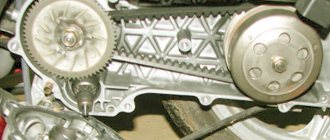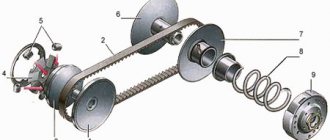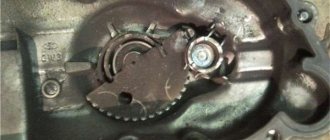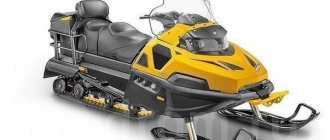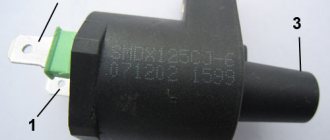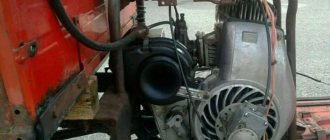When is it necessary to change the belt on a scooter?
Replacing the scooter's variator belt may be necessary in the following cases:
- When adding gas, the engine revs up easily, but the scooter stays still. The clutch does not engage. All signs of a broken belt.
- The compression is good, the carburetor works properly, but the scooter cannot reach maximum speed, although it used to be able to do this with ease. There are all signs of belt wear. It cannot reach the maximum radius, hence there is dynamics, but no maximum speed. Obviously the belt needs to be replaced.
- Over time, the belt has become “oaky” and slips in the pulleys.
- Due to the poor workmanship of “usually Chinese products,” the belt stretched. A significant deviation from the nominal will never allow the scooter's transmission to work properly.
- Other.
Checking and replacing the scooter's variator belt
Published November 3, 2009
Author's article Tron Igor
General recommendations for scooter maintenance Proper running-in of the scooter Adjusting the scooter valve clearances Centrifugal clutch - removing, installing, replacing pads Is the flying season over? It's time to think about preserving your scooter Spring delights or How to start a scooter after winter Instructions on changing the engine oil of a scooter Instructions on changing the transmission oil of a scooter Instructions on cleaning the air filter of a scooter Checking and replacing a scooter's variator belt Replacing a scooter's variator belt without disassembling the variator Scooter tires Maintenance of cables, locks and other scooter mechanisms Replacement of wheel bearings and brake disc Repair and maintenance of chain scooter transmission
Many new scooter riders, especially those who are not familiar with technology in general, when buying a scooter, have no idea that such an element as a variator belt will one day/soon become unusable, especially if the scooter is not new. However, it is always important to ascertain the “point of condition” of the belt in time, otherwise there is a danger of getting firmly stuck somewhere. Generally speaking, a normal variator belt should last at least 6000 km under normal conditions - this is the minimum. Normal conditions here mean, firstly, the correct installation of the belt, with the stated dimensions. Secondly, the riding style of a scooterist, because you can “lose” a new belt in a week, endlessly skidding and accelerating in a childish way. Thirdly, it should be borne in mind that with prolonged inactivity the belt may also become unusable. In this sense, the belt on a new scooter (especially a Chinese one) may not pass the required minimum - a consequence of tedious downtime in damp warehouses.
Although in most cases a worn-out belt begins to slip significantly*, which is noticeable (from the dynamics of the scooter) even without a visual inspection, I would recommend checking the belt every 1500 - 2000 km, but not only for signs of wear. Some belts (again, especially Chinese ones) during their first 1000 - 3000 km begin to “lose” the top layer, which is a fabric braid. The remains of this braid in the form of fluff clog all possible cracks, corners and ventilation holes in the inside of the variator body, which instantly leads to an increase in the operating temperatures of the scooter's variator components. You understand that this is extremely undesirable.
* belt wear is not the only reason for slippage; it could also be, for example, a weak spring stiffness of the driven pulley.
It is quite easy to determine the condition of the belt by eye - the presence of cracks indicates its imminent collapse. The belt can crack both along (delaminate) and across (fall apart). In this case, replacement is necessary without delay.
What are the dangers of a belt breaking on the road? The photo shows a typical case of belt delamination. Replacing a torn belt is not so difficult; it is not necessary to disassemble part of the variator. But at the moment when the belt fails, the movable cheek of the drive shaft becomes “uncontrollable”, and at this moment it is very easy for the weights to fall apart. My belt broke twice, and both times the weights fell apart, in one case several flew out of my cheek, and in the other they remained inside, but fell out of their tracks. If you can disassemble the variator in the garage - using a gas wrench - then in road conditions it is extremely problematic, almost impossible, to unscrew the variator fastening nut, I was convinced of this. For this case, a special puller is needed. In the worst case scenario, you will have to call a tow truck. Fortunately, today there are quite a few companies providing evacuation services for cars and motorcycles. But, fortunately, I did not have to use expensive tow truck services - once in the city center it happened, another time in an open field. But fortunately for me, one of my friends was driving along this road at that time in a cargo-passenger Gazelle.
But the same thing is done using a gas key.
What happens if you install a belt of the wrong size? Maybe nothing special, just the dynamics of the scooter will change, perhaps the maximum speed. However, it is not for nothing that each scooter model has its own belt size. And installing a non-standard one can end badly. Here's a good example. After the scheduled replacement of the used belt, the new one (Taiwanese belt, decent quality) traveled only about 1500 km, when suddenly, on the descent from the hill, at high engine speeds, it was torn into pieces. It turned out that the new belt is about 1.5 mm wider than the standard, contrary to the dimensions written on it. As a result, at high speeds, the belt came out of the cheeks higher than necessary, and at one moment it simply caught on the edge of the cheek and came out “outside” (after all, the belt is under constant pressure “on the sides”, due to which it is pushed out by the cheeks larger diameter), where the cheek diameter is much larger. Unable to stretch any longer, the belt gave way at the ends, of which there were as many as 6 pieces - it was torn into 3 parts. So, even when buying the “right” belt, compare it with similar ones, otherwise you never know.
That's it, fair wind, and good belts for you.
General recommendations for scooter maintenance Proper running-in of the scooter Adjusting the scooter valve clearances Centrifugal clutch - removing, installing, replacing pads Is the flying season over? It's time to think about preserving your scooter Spring delights or How to start a scooter after winter Instructions on changing the engine oil of a scooter Instructions on changing the transmission oil of a scooter Instructions on cleaning the air filter of a scooter Checking and replacing a scooter's variator belt Replacing a scooter's variator belt without disassembling the variator Scooter tires Maintenance of cables, locks and other scooter mechanisms Replacement of wheel bearings and brake disc Repair and maintenance of chain scooter transmission
Tweet
#1 Kirill
25 March 2010 20:42
I bought a Chinese scooter... I drove 30 kilometers, at an engine speed of 3000, the scooter starts to twitch, what could it be? Stealth Tactic scooter 150 cc. It stops twitching at 3100..
#2 Kirill
25 March 2010 20:43
Anyone who can help write to ICQ 482717075
#3 Ruslan
10 April 2010 18:15
drove about 4000 km (3 seasons), never changed the belt until one day, driving down a hill, it was torn into pieces. I've been struggling with it for two weeks now. I bought a belt of standard sizes, BUT the problem is how to remove this sprocket (I tried everything, and a traffic wrench, and a board, and much more to fix it... it still scrolls. What other advice can you give?
#4 Sasha
12 April 2010 22:00
The same scooter as Kiril's. After replacing the belt, the clutch does not disengage (it immediately starts idling and jerks).
#5 Albert
13 April 2010 21:41
Ruslan! Try using a double-sided open-end hook to rest one end between the teeth of the fixed cheek of the variator, the other end into the crankcase body so that this cheek does not rotate... then use a suitable wrench to unscrew the nut. I’ve done this more than once... it works)
#6 Andrey
21 April 2010 10:00
Folks, I installed 90cc and a top racing CVT on the lead af 20, the standard belt is flying out of the neck, what should I do? It doesn’t fly out completely, in my opinion only half
#7 !!!NOVEL!!!
21 May 2010 11:08
what kind of belt is needed for a honda dio sp please tell me!!!
#8 Oleg
27 May 2010 20:58
Which way should I unscrew the nut, clockwise or counterclockwise?
#9 TOX@
28 May 2010 23:51
Bros, tell me when I start driving, something creaks in the variator covers?
#10 Olga
07 June 2010 14:24
Tell me what kind of belt is needed for the ABM ELITE scooter?
#11 Airat
10 June 2010 15:03
Tell me the size of the belt for the Honda Squash, can I get one from Tact or Dio?
#12 Airat
10 June 2010 15:05
Got it without a belt
#13 Ivan
20 June 2010 02:17
Tell me, I have an old Yamaha BJ, there is a belt with a steel cable on the sides. Is this how it should be or has it already rubbed against the cable? (14 thousand km) and should there be lubrication on the belt? (in my version, by the way, the valve cover is sealed with gaskets and everything closes tightly)
#14 BOGDAN
22 June 2010 11:39
IVAN THERE SHOULD NOT BE ANY LUBRICANT ON THE BELT! AZA CABLE PROBABLY SHOULD NOT BE
#15 ABM
22 June 2010 23:18
Guys, why can there be a crunching sound in the variator? I’m still driving quietly. When I let off the gas, something starts to crunch. And are the belt tensioners here? Like on a car?
#16 Yuri
23 June 2010 00:41
Which way should I unscrew the nut, clockwise or counterclockwise?
#17 Yuri
23 June 2010 16:59
Vsjo!!! Open!
#18 andrei
12 July 2010 15:21
Guys, tell me in which direction the nut on the sprocket should be unscrewed in order to install the belt
#19 Jog
13 July 2010 08:51
You have to unscrew it counterclockwise
#20 Jog
13 July 2010 08:54
Wait, on the sprocket - do you mean the bolt in the front variator, where else do the rollers go? There, yes, counterclockwise, like everywhere else, in principle 
Home Scooter maintenance Maintenance, replacement of the scooter variator belt.
How to properly replace the variator belt on a scooter
To replace a scooter's variator belt, you need to remove the cover and perform a number of steps depending on the scooter model. Let's look at the whole process in more detail:
Removing the variator belt on a scooter
- Place the scooter on the center support.
- Unscrew the bolts securing the variator cover. The bolts can be: a) hex wrench - everything is clear here, use a quality tool. b) under a screwdriver - here it is better to use an impact screwdriver, because it is very easy to rip off the slots with a regular screwdriver. c) under a socket wrench - in this case it is better to use socket heads (usually 8 or 10). You shouldn't mess around with an open-end wrench.
- There is no need to unscrew the kickstarter tab. It doesn’t bother us, but only if the additional plastic casing on the variator cover is not used. If such a casing is installed, the tab must be unscrewed. To do this, unscrew the fixing bolt completely and remove the foot from the slots.
- Now that all the bolts securing the variator cover are unscrewed, it must be removed by pulling it to the side. It could be stuck by means of a gasket, in which case it can be torn out of place by lightly tapping it.
- Now you definitely need to check the belt for wear and other damage. As a rule, wear in width by more than 1 mm from the nominal value determines a mandatory replacement for the efficient operation of the entire transmission as a whole. The belt size is indicated in the owner's manual for each scooter model. The presence of mechanical damage, cracks, tears and other defects also determine replacement. The width of the belt is checked with a regular caliper.
- Now you need to determine whether it is possible to remove the scooter belt without dismantling the drive and driven pulleys of the variator. To do this, use both hands to push the halves of the driven pulley apart, pulling the outer pulley towards the clutch bell. The belt should sink as much as possible. Now you need to check whether the belt can be pulled out through the drive pulley. Rotate the crankshaft while attempting to thread the belt through the outer radius of the drive pulley. If such an opportunity exists, great. Let's move on to the clutch block. Pay attention to the location of the top and bottom points of the driven pulley. They can be located very close to the crankcase, and the belt simply cannot fit through such a gap. In this case, it is necessary to dismantle the driven pulley by unscrewing only one clutch bell nut. If the distance allows you to pull out the belt without dismantling the clutch (and on many scooters this is the case), then the entire process of replacing the belt turns into a matter of several minutes.
Scooter CVT – is it worth tinkering with?
Why, in general, do you need a variator on a scooter? Not a single decent vehicle, and a “decent” scooter, can do without a device that would change the ratio of engine speed to drive wheel speed. Otherwise, the car would not pull uphill, would not be able to move smoothly and even accelerate. The engine speed is regulated by the gas, but at the same time not only the speed changes, but also the power. And sometimes the high power that is achieved at full engine speed is also required at low speed.
In cars, this unit is a gearbox - manual or automatic. It starts in first gear, accelerates in second, and in third and subsequent gears it already drives in accordance with the set speed limit. So, a variator on a scooter is, to put it simply, a gearbox, only a continuously variable one, based on a different principle of operation. In it, the change in engine speed and wheel speed does not change abruptly, but smoothly, in automatic mode. But the essence, the functional meaning is the same.
There are different types of variators, but the most common is the mechanical V-belt. The principle of its operation is easy to imagine by looking at a bicycle with a Shiman gear shift system. Sprockets of different diameters are installed on the pedals and on the drive wheel; the chain is switched by the cyclist from one sprocket to another. As a result, you can spin the wheel five times by spinning the pedals once, or you can make the ratio of revolutions one to one.
The same thing happens in the variator. Only there is not a chain, but a belt, and not a pyramid of sprockets on the driven and drive shafts, but shafts with a variable diameter along the length. The belt, moving horizontally, grabs the larger or smaller diameters of these shafts, smoothly “switching speeds.” This shift is carried out by special weights under the influence of centrifugal force; when they unwind, they move the belt. The belt must be correctly tensioned and fit snugly into the shaft. But you shouldn’t pull it too tight; the engine will have to spend extra power to transfer rotation to the wheel. If the belt is loose, it will slip and wear out. In everything you should adhere to the golden rule of the mean.
Typically, the variator is fully adjusted at the factory. By and large, there is no point in going inside. You can’t do it yourself better than the experts did. But it is human nature to want to achieve perfection. It may seem to him that the scooter drives “wrong”, precisely because of an incorrectly configured variator. This really does happen. The belt may have worn out or stretched, or the center spring may have weakened. Such things have their own symptoms that need to be monitored. It is worth noting that when accelerating, the engine revs at high speeds, and the scooter accelerates weakly or jerkily, then most likely the problem is in the variator. Acceleration should be smooth and consistent with engine speed. It is worth removing the cover from the variator and looking at how tensioned and how the belt is positioned.
On the drive shaft - on the engine side, it should capture the smallest possible diameter, and on the drive wheel side - the largest possible. Then the torque on the wheel will be maximum. The scooter will move off easily. The belt should be in the same position at idle. In this case, the belt should fit tightly and not slip. The main setting comes down to the correct belt tension. If it is stretched or worn, it should be replaced with a new one. At the same time, it is better not to experiment with belts designed for other CVT models. It matters not only the length, but also the width and thickness. A belt that is too wide, moving, will rest prematurely and will not allow you to achieve the optimal ratio between engine speed and wheel rotation.
Incorrect operation of the variator may also be due to wear on the rollers mentioned above. If they become angular, then they should also be replaced. And again, do not try to install them from another model. Each variator is designed for a specific type and weight of rollers. So if everything is in order with the belt and rollers, then it is better to seek help from a more experienced scooter rider or a professional.
